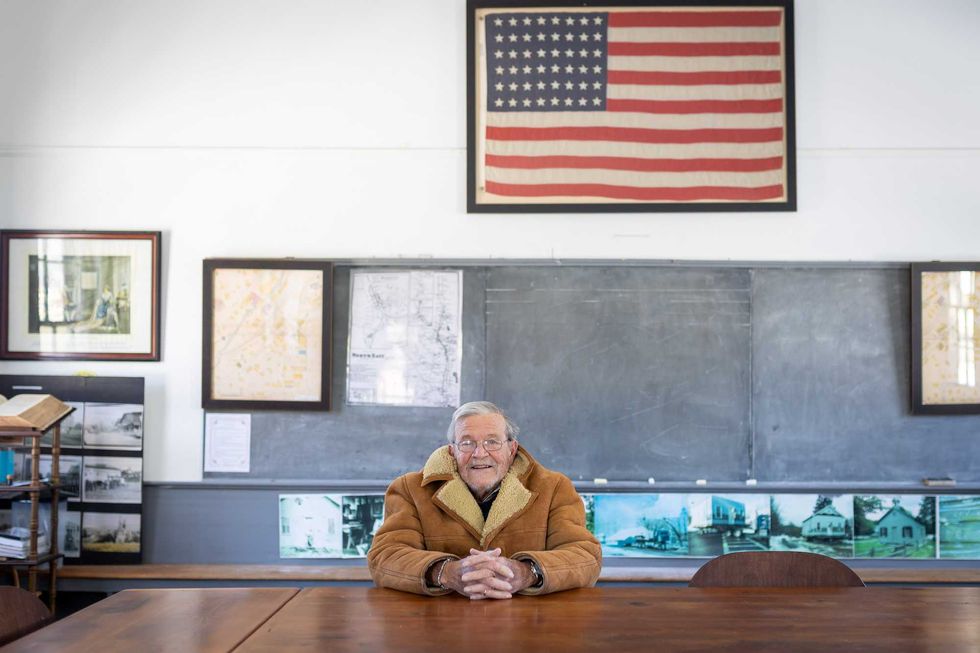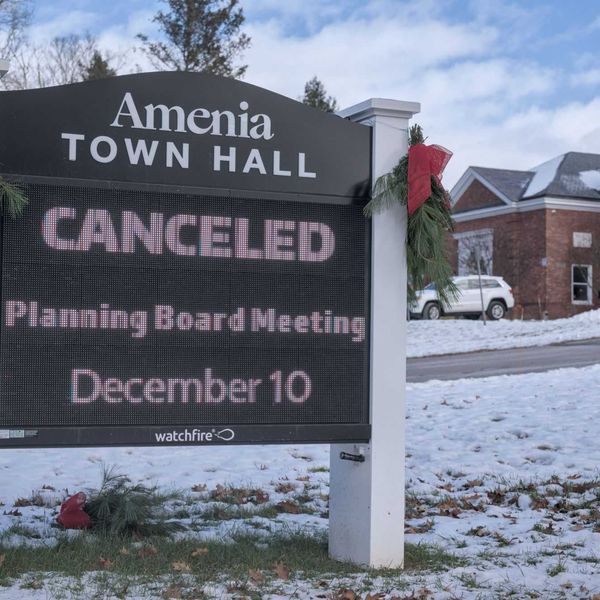Latest News
Education center proposal at a crossroads as Millerton awaits approval of new parking requirements
Dec 19, 2025
The former Presbyterian church on Main Street in Millerton, which Millerton resident Alex That has proposed converting into a private education center
By Nathan Miller
MILLERTON — Millerton resident Alex That presented plans for the former Presbyterian church on Main Street to the Millerton Planning Board at a rescheduled meeting Tuesday, Dec. 16.
That is proposing to convert the church into a private education center offering classes in music, video production and DJing for people of all abilities.
The Millerton site would be the second location for Caffeine Academy, which opened its first location in West Babylon, N.Y., in 2013.
The meeting was marked by confusion over the village’s application approval process, with That and his architect repeatedly asking board members to clarify what steps were required and in what order they would occur.
During public comment, Zoning Board of Appeals Chair Kelly Kilmer explained there are two potential paths forward for the application.
One option would require That to apply to the Zoning Board of Appeals for a parking variance, a process that would involve a full environmental review and public hearings separate from those required by the Planning Board.
The second option would be to wait for a recently passed local law to take effect. The law exempts buildings in the village’s General Business District from additional parking requirements, which would eliminate the need for a parking variance.
“The Village of Millerton Board passed a local law amending the village code for the General Business District and parking variances, which, in all honesty, Alex, works in your favor,” Kilmer said.
Kilmer said Local Law C must be stamped and filed by the New York Secretary of State before it officially goes into effect. The process typically takes between 30 and 60 days and could be further delayed by the holiday season.
Until that approval is finalized, the Caffeine Academy proposal would require parking variances from the Zoning Board of Appeals.
“If you want to move forward, you would fill out an application,” Kilmer said. “I’ll make sure that we get a meeting together.”
Planning Board members recommended that the application move to the Zoning Board of Appeals for a parking variance. However, it remained unclear at the end of the meeting whether That would proceed with that option or wait until Local Law C is officially on the books.
Keep ReadingShow less
The former agricultural weigh station at 7723 S. Main St. in Pine Plains, where the Planning Board approved plans for the proposed Upstate Pines cannabis dispensary.
By Nathan Miller
PINE PLAINS — Planning Board members granted final approval Wednesday, Dec. 17, for two major commercial projects: the proposed Upstate Pines cannabis dispensary and a large lumber mill and showroom.
The site plan for the dispensary was approved by a 6–0 vote.
The proposed cannabis dispensary will be the second location of Red Hook-based dispensary business Upstate Pines, founded by Brian Seiler, Ben Abrahams and Ben Abrahams in 2024. Planning board members approved site plans that propose to utilize the former historic weigh station building at 7723 S. Main St. across from the Pine Plains Post Office.
The proposal, designed by architect Kristina Dousharm, underwent a lengthy approval process that included public comment earlier in the fall. Residents urged the board to be mindful of the building’s historic character — as the community’s former agricultural weighing station — and raised concerns about its proximity to the Pine Plains Firehouse on an adjacent parcel and the Post Office.
Although Pine Plains’ local law prohibits dispensaries within 300 feet of the firehouse or the Post Office, state law supersedes those restrictions. Planning Board members ruled in October that the local provisions are unenforceable, eliminating the need for a waiver.
Board members also approved the site plan and granted necessary waivers to The Hudson Co., which plans to build a 50,000-square-foot lumber mill, office building and showroom just south of Stewart's Shops gas station on Route 82 at the southern entrance to downtown Pine Plains.
Approval was unanimous with a 7-0 vote and no abstentions.
The lumber mill will produce wood beams, flooring and paneling.
Hudson Co. representatives proposed the large mill and expanded campus because the operation had outgrown a manufacturing facility it currently occupies at 2290 Route 199 in Pine Plains. LaBella Associates engineers designed the expanded campus.
The Upstate Pines cannabis dispensary first went before the board in August, and the Hudson Co. mill and showroom has been under review since May.
Keep ReadingShow less
Ralph Fedele sits at a desk in the historic Irondale Schoolhouse, which he led the effort to relocate to downtown Millerton.
Photo by Aly Morrissey
MILLERTON — After serving for 12 years on the North East Town Board, Ralph Fedele says he has only one regret.
“I wish I could be called a ‘local,’” he joked with a warm, booming laugh.
Fedele moved to Millerton from New York City 37 years ago, in 1988, and has since worn many hats — volunteer, historian, advocate, elected official — yet he still doesn’t believe he’s earned that title.
“I’m a transplant,” he said matter of factly. “I’m from the city.”
Before settling in Millerton, Fedele spent 25 years working in merchandising at JCPenney.
His roots, however, trace back to Rhinebeck, where he grew up on a 97-acre farm and enjoyed what he describes as an idyllic childhood.
“It was marvelous,” he said, with a twinkle of nostalgia in his eyes. As a boy, he climbed apple trees, spent hours in the family barn’s hayloft, played with neighbors until sunset, and helped his Sicilian grandmother — his nonna — in the garden. Today, Fedele wears her ring. “Any time I’m a little depressed or I want to remember,” he said, “I can talk to her.”
Growing up with an Italian grandmother sparked a lifelong love of history and culture. That curiosity eventually took Fedele to Italy, where he visited the church in which his grandmother was baptized. “Because I love history so much, I wanted to know where my grandmother was from, so I traveled to her village in Sicily.”
Along the way, he uncovered another piece of family history. His great-grandfather, Giovanni Nicolini, was a noted Italian sculptor whose work still stands outside Palermo’s Teatro Massimo, the largest opera house in Italy. Fedele later made a pilgrimage there and photographed his ancestor’s name on the bronze plaque outside of the theater.

The Irondale Schoolhouse
Years after settling in Millerton full time, Fedele was driving north on Route 22 when he spotted an old, classic building and couldn’t stop thinking about it.
“It was in dire straits,” he recalled. “Right on the road, but beautiful. I remember thinking, ‘Wouldn’t that be a great building to move into the village?’”
That moment would eventually turn into Fedele’s lasting legacy.
He left his post at the North East Historical Society to found Friends of the Irondale Schoolhouse, leading an eight-year effort to “move, restore, and repurpose the building.”
Supervisor Chris Kennan said the project remains inseparable from Fedele’s name. “Every time I pass by the Schoolhouse, I think of Ralph,” Kennan said. “It was his vision and persistence that enabled this dream to become a reality.”
Fedele joked that people may have thought he was crazy during the lengthy restoration. “I was a tyrant,” he said with a laugh. “I really made sure that we were able to get it done.” The effort required coordination with the state, the county, village and town officials, and his newly assembled nonprofit board.
As a self-proclaimed history buff, Fedele didn’t stop at the restoration. He found a list of students in old records and did what any determined historian would do. He opened the telephone book and started making calls.
Eventually, he tracked down one of the schoolhouse’s original students — Mary (Mechare) Leitch — who, at the age of 101, returned to the building after renovations were complete.
“It was a marvelous time,” smiled Fedele. “I was so happy to see her.”
‘Trust is earned’
Today, even though he won’t call himself a local, Fedele is a familiar fixture in town. You can find him each week enjoying conversation and a cup of coffee at Talk of the Town Deli, or getting stopped in town by neighbors and friends for a chat.
“I have gained the trust and confidence of a lot of people,” Fedele said. “It comes a little bit at a time. Trust is earned.”
Not only has Fedele served as a town board member, he has volunteered for Townscape and served as the president of the North East Historical Society. He was also one of the first advocates of preserving history by fixing toppled gravestones at the Spencer’s Corners Burying Ground.
His service was formally recognized at his final Town Board meeting through a resolution commending his three four-year terms as councilman, citing his “good humor, kindness to all and deep concern for the community’s senior citizens and for those living on fixed incomes.”
An emotional Fedele addressed the room with a mantra he often repeats. “When you leave, leave this place a little bit better than you found it,” he said. “That’s what I have always tried to do.”
Neighbors react
During the public comment, several residents stood to thank Fedele.
Claire Goodman, a member of the village Zoning Board of Appeals and Townscape volunteer, said Fedele was among the first to welcome her to Millerton.
“Whether we’re standing out in the cold, scrubbing tombstones at Spencer’s Corners, or ringing the bell at the schoolhouse, you always have such grace and you’re such a gentleman.” She added, “The way you laugh, it opens my heart.”
Kathy Chow, who serves on the Conservation Advisory Council and the Climate Smart Task Force, referred to Fedele as a “pitbull,” adding, “We all have hard things that we do, and we keep pushing at it, but you’re the one who makes me think I can keep going.”
Fedele describes his retirement from the town board as bittersweet. “I’m going to miss this,” he said. “I really am.”
Keep ReadingShow less
Mad Rose Gallery on Route 44 in the Village of Millerton is decked out with lights and decorations to celebrate the holiday season.
Photo by Aly Morrissey
MILLERTON — The Village of Millerton is inviting residents and businesses to enter its annual house decorating contest, with judging now underway through Dec. 28.
Awards will be presented in several categories, including Best Lights, Most Creative, Best Overall and Best Commercial Front.
Entries will be evaluated by a panel of judges using established criteria. Creativity will be judged based on originality, variety of materials used and the use of homemade vs. commercially made decorations. Appearance will consider color coordination, balance and overall attractiveness, while effort will reflect the time and energy put into preparation and presentation.
Judging will be conducted by drive-by observation between 6 p.m. and 11 p.m., and displays must be clearly visible from the street side of the house at night. People and pets may not be included as part of the design.
Winners in each category will receive a gift basket, gift certificates and recognition in The Millerton News. Awards will be distributed on Friday, Jan. 9, 2026.
The contest is open to residents and businesses in the Village of Millerton and the Town of North East. Entry forms can be obtained from Village Hall or at villageofmillerton-ny.gov.
Questions may be emailed to deputyclerk@villageofmillerton-ny.gov
Keep ReadingShow less
loading









